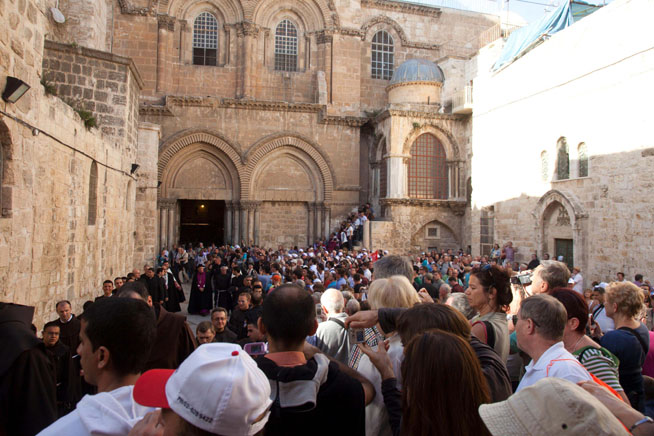
For three or four years now, the State of Israel and the Palestinian Authority have been very pleased with the record number of visitors to the country registered by the Ministry of Tourism. If, on the one hand, the excellent condition of the economy linked to pilgrimages and tourism cannot be denied, on the other hand, this situation triggers off a number of side effects: the holy places are taken by storm, the guides do not always show the respect they should and in the crowds that are characteristic of the naves of churches in this period, the pilgrim pays more attention to keeping the place he or she has conquered with great effort rather than meditate on the mystery commemorated there.
In this connection, Sundays at the Holy Sepulchre have become disagreeable. The basilica is crammed and people almost climb over one another in front of Christ’s Tomb.
It is a long way from the dawn of the Resurrection in a deserted garden.
For those who, amidst all this noise and confusion, cannot “withdraw into themselves” and concentrate so that they can meditate on the mysteries of the Passion, there is nevertheless a good method to be able to pray: by following the procession of the Franciscans, which is celebrated every day, but in a particularly solemn way during the Sundays of Lent. On these occasions, the Patriarch (or his representative) and the Franciscan seminarians, together with those of the Patriarchate, are also present on these occasions.
Follow the Friars Minor, the guardians of the holy places. If occasionally they have to restrain the fervour of pilgrims, it is because they have been there for eight centuries to ensure a real life of prayer in the places of the Salvation.
Follow their footsteps, take advantage of the life of the sanctuary which in a second is fixed around them, recite the Lord’s Prayer or Salve Regina with them, sing the Vexilla Regis with them, let yourselves be carried away by the Gregorian chanting and by the organ and walk around the empty Tomb once and then a second time. And if the experience in the afternoon is not enough for you, join them again for the Office of the Readings at 11.30 p.m. When you see the celebrants leave the Tomb, holding the Gospel high, when you hear the Resurrection being proclaimed, then you will have reached the source of the Salvation. Then, listening intently, in this unusual garden that has blossomed again thanks to your prayer and that of your brothers, you will hear his voice, calling you by name, as on that Easter morning.
Mab
In this connection, Sundays at the Holy Sepulchre have become disagreeable. The basilica is crammed and people almost climb over one another in front of Christ’s Tomb.
It is a long way from the dawn of the Resurrection in a deserted garden.
For those who, amidst all this noise and confusion, cannot “withdraw into themselves” and concentrate so that they can meditate on the mysteries of the Passion, there is nevertheless a good method to be able to pray: by following the procession of the Franciscans, which is celebrated every day, but in a particularly solemn way during the Sundays of Lent. On these occasions, the Patriarch (or his representative) and the Franciscan seminarians, together with those of the Patriarchate, are also present on these occasions.
Follow the Friars Minor, the guardians of the holy places. If occasionally they have to restrain the fervour of pilgrims, it is because they have been there for eight centuries to ensure a real life of prayer in the places of the Salvation.
Follow their footsteps, take advantage of the life of the sanctuary which in a second is fixed around them, recite the Lord’s Prayer or Salve Regina with them, sing the Vexilla Regis with them, let yourselves be carried away by the Gregorian chanting and by the organ and walk around the empty Tomb once and then a second time. And if the experience in the afternoon is not enough for you, join them again for the Office of the Readings at 11.30 p.m. When you see the celebrants leave the Tomb, holding the Gospel high, when you hear the Resurrection being proclaimed, then you will have reached the source of the Salvation. Then, listening intently, in this unusual garden that has blossomed again thanks to your prayer and that of your brothers, you will hear his voice, calling you by name, as on that Easter morning.
Mab

